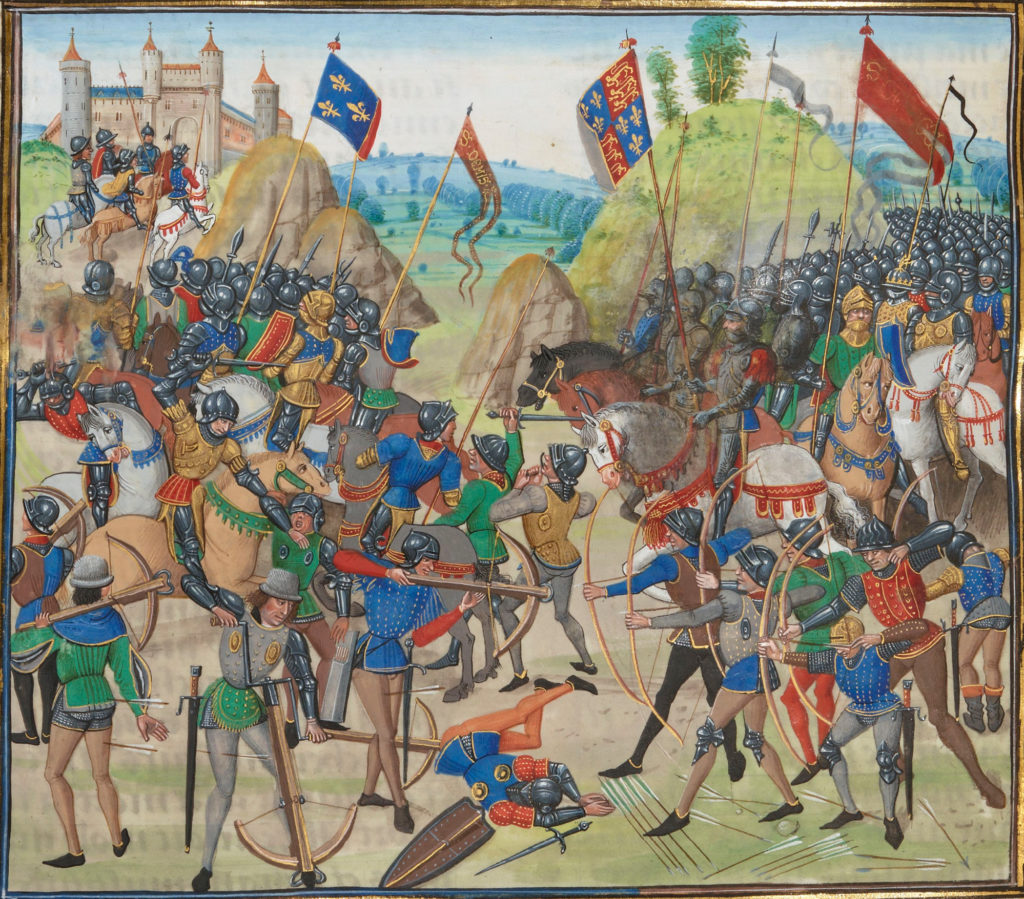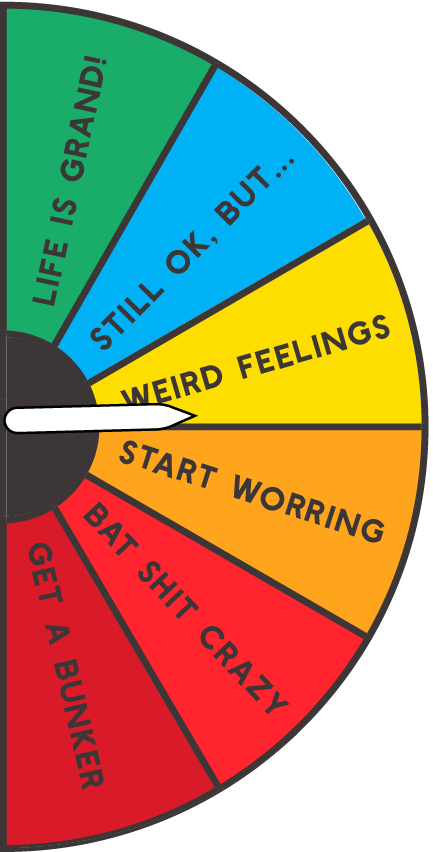Volcanoes are erupting in The Philippines, but on-fire Australia received some welcome rain. The Iran war cries have been called off and The Donald’s military powers are about to be hamstrung by the Senate. Meanwhile, his impeachment trial is starting, and we’re all on Twitter for a front-row seat.
Violence Is So Last Millennium
Genocides, war, murder, you name it: the world has seen a serious decline in violence. It’s a much friendlier place as a result.
The following is excerpted from Your World, Better, a book about global progress and how to keep it going, by The Progress Network Member Charles Kenny. While it is written for middle-schoolers, the data Kenny cites and his suggestions for action steps are just as educational and useful for adults—read for yourself or share with a kid you know who feels depressed about the state of the world. You can download the entire book (free as a PDF, and for a modest fee for an e- or print-version) here.

The Hundred Years’ War was a conflict between England and France that actually lasted 116 years. To be fair, they took breaks. The years 1360 to 1369, for example, were reasonably peaceful, in part because the French king spent a lot of that time as a hostage in England. But, pretty much, 1337 to 1453 was over a century of bloody conflict over French lands and who should rule them that killed 2 million people or more.
For the average English or French subject, the war was an utter waste of lives, time, and money. And that was hardly the exception: the great majority of wars in history may have led to the glory of a victorious royal and some barons and lords, perhaps the exchange of land and the people who live on it, but it has involved little but suffering and death for those people themselves.
And many conflicts were far more deadly than the Hundred Years War: 1900 years ago, China’s War of the Three Kingdoms killed more than 30 million people. So, it is a wonderful thing that not only war, but violence in general, has been declining recently. In fact, over the very long term, violence has gone from a major cause of death to a comparatively rare and tragic event across most of the world.
About the time your grandparents were thinking about having kids, the United States introduced a lottery to help decide which Americans would have to fight in the Vietnam War. More than 2 million American men ended up being drafted, made to join the army if he wanted to or not. The war killed 57,000 American troops and more than one million Vietnamese soldiers and civilians. The communists ended up winning, which likely would have been the result had the Americans stayed at home. But a lot fewer people would have died in the meantime.
There was a lot of violence back home in America as well around the time when your parents were born. During the 1970s, groups including Symbionese Liberation Army kidnapped people for ransom, and 112 US planes were hijacked. The civil rights leader Martin Luther King and Robert Kennedy, a Democratic candidate for the presidency, were both shot and killed in 1968. King’s assassination led to massive riots in cities including Washington DC, Chicago, and Baltimore. And the overall murder rate peaked at about one killed for each 10,000 Americans each year in the 1970s.
Of course, the US is still fighting wars, most recently in countries including Afghanistan and Iraq. More than 14,000 US soldiers and contract fighters have died in those two conflicts since they began, along with around 100,000 Iraqi and Afghan troops, about the same number of opposition fighters, and 250,000 Afghan and Iraqi civilians. But it is still safer to be a US soldier today than it was in the 1990s, let alone the 1970s: the risk of dying from enemy action or accidents is less than it has ever been.
And for those of us not in the military, life is even safer still. The murder rate in the US is now about half of the level it was in the 1970s, 80s, and 90s. Your risk of dying in a terror attack in the US is a lot less than your risk of dying from a bee sting or drowning in the bath (both of which are extremely unlikely). Hate crimes against minorities and violence against women have both been declining in the US over the past 30 years.
The chance that a person is murdered in the US today is less than the chance of flipping a coin and getting heads, doing it again, and again, and again, and again, and again, and again, and again, and again, and again, and again, and again, and again, and again—that’s heads 14 times in a row. And the chance is less than that for kids under the age of 14—add two more coin flips, for a total of 16 heads in a row. Violence in this country is far too high, and we should make it much rarer. But it is still already rare. In terms of risk, most people should be more worried about things like not texting while they are crossing the street so that they don’t get run over.
Most children practice lockdowns at school because sometimes, rarely, people try to hurt kids there. But school is still one of the safest places to be in, with teachers, police, and parents working to make sure students are protected. And criminally violent acts in US schools like assault have gotten rarer just in the past 20 years, from about one case for every 100 students over the age of 12 in 1993 to about one for every 500 students in 2015.
Looking worldwide, at around the time your grandparents were born, the Korean War was being fought. That was a major reason why more than 546,000 people died in battle planet-wide in 1950. As we have seen, around when your parents were born, the Vietnam War was raging and about 290,000 died in battle in 1972. The tragic conflict in Syria over the last few years has been responsible for hundreds of thousands of deaths, and 105,000 people died on the battlefield worldwide in 2014—the worst recent year of violence. But as these numbers make clear, the trend has been toward a lower number of deaths. An average person’s annual risk of dying in battle worldwide has fallen from one chance in 5,000 in 1950 to one chance in 85,000 in 2016.
The amount we spend on war is also going down. At the start of the decade in which your parents were born, one out of every $20 of the world’s income was used to fund armies, navies, and air forces. Today that is closer to one out of every $46. The US spent about one out of every $13 of its income on the military in 1970 compared to one out of every $32 today. That means it is spending more than the average country, but still less than a few decades ago.
Through history—and today—far more people worldwide have died violent deaths off the battlefield than on it. Governments themselves have been a major cause. Genocides have killed many millions in the last century, but thankfully, genocides have become less common in the last few decades. The risk of murder has also dropped dramatically over history. Typical murder rates in Europe in medieval times were more than 20 times their level today. More recently, the murder rate has been falling around the world, at least since the 1990s. In India, the risk of being murdered fell from one chance in 22,000 in 1991 to one chance in 35,000 in 2010.
There is an argument over what accounts for the decline of war and murder worldwide, and if it will continue. But people are turning against the idea of all sorts of physical violence. We used to torture animals for fun in circuses and bull fights; now that is dying out. Hunting as a sport is becoming less popular. The proportion of parents in the US who disagree with the idea of spanking children as a punishment increased from one out of six in 1986 to one out of three in 2016.
Worldwide, the number of countries that use the death penalty for any crime has dramatically fallen. In the mid-1970s, about 20 countries had banned the death penalty. By the mid-1990s, that had climbed to around 60 and by 2010 to over 100. The number of people worldwide who say they wouldn’t fight for their country is growing. No one thinks countries should fight a war for glory or slaves anymore, and ever fewer people think it is right to fight a war for resources or land.
One factor behind all these changed attitudes may be the other, better, ways to riches and glory. In the past, taking someone else’s land or their gold was a great way to wealth—but you might have to kill them to take it. Nowadays, the more reliable way for people and countries to get rich is to make and sell new stuff rather than taking old stuff. And people and countries who rely on selling things do better when the world is peaceful than when it is at war. Meanwhile, for the rest of us, the risk of getting into a fight and getting killed didn’t look as bad if we might have died of smallpox the next day anyway. But now that a peaceful life can last for 80 years or more, getting into a fight looks ever more stupid and risky.
Beyond changing attitudes, good policing in countries and cooperation between them has also played a big role in reducing global violence. Within countries, people are less likely to get away with murder than they used to be. And internationally, the United Nations can cut countries off from trade or put together alliances to respond if one country attacks another. Peacekeepers—soldiers lent to the United Nations so that it can end wars and maintain stability—have played a big part in controlling conflict in countries in Europe, Asia, the Middle East, and Africa.
The world is still far from utterly peaceful. One third of children aged 13 to 15 in the United States report they were in a physical fight last year at school. America remains a lot more violent than most rich countries. The chance of being murdered in the US is ten times the risk in the Germany. A big part of the difference is due to easy access to guns in America. American households own more guns than there are people in the country. That compares to about one gun for every five people in Germany.
And in some countries, a lot of children report being physically punished by teachers—more than three quarters of all children aged eight in India, for example. Often, the teachers aren’t breaking the law: 69 countries allow school staff to use physical violence to discipline children. Reports of fighting and bullying are even more frequent than in the US. Again, in India, about one quarter of women between the ages of 15 and 49 report their partner, usually a boyfriend or husband, has physically attacked them in the past year, part of a worldwide epidemic of household violence.
More seriously still, the risk of being murdered in countries including India, Italy, and the US is still only about the same as when your grandparents were born—the 1950s were also a low point in homicide rates. In some countries in Central America in particular, a growing number of people are victims of violence, much of it related to the illegal drug trade.
Looking at weapons of war, although about one sixth the number in the 1980s, the world still contains more than 10,000 nuclear weapons, still quite enough to end human civilization.
And ongoing conflict in Afghanistan, Yemen, South Sudan, and Syria is creating widespread misery alongside deaths. It has also created a wave of refugees escaping the violence, part of a total 25,900,000 people worldwide who have fled their home countries.
What can you do to help reduce violence and help those suffering the consequences? At school, you should report any violence you see. You can support campaigns to reduce the number of the deadliest guns on America’s streets through groups like Students Demand Action for Gun Sense. You can work with organizations pushing for international agreements to reduce the number of weapons countries sell to each other, like the International Campaign to Ban Landmines. You can write to your Congressional representatives arguing for more support to United Nations peacekeeping missions.
For the people who are forced to leave their own countries because of war or violence, you can help them by welcoming them into your communities. Older refugees need somewhere safe to live and work. Younger refugees need to go to school, and they need friends. There are many local groups that help refugees settle into new homes. Think about volunteering with one of them.
People wounding and killing other people has been a tragic constant of human history. But it is happening less than it used to. Violence to gain advantage or win a dispute is going out of fashion, and the world is a more friendly place as a result.
You can download Your World, Better (free as a PDF, and for a modest fee for an e- or print-version) here.


